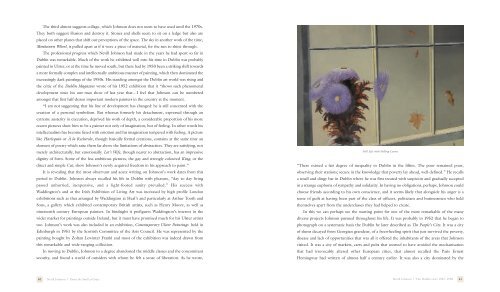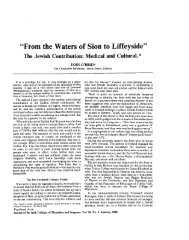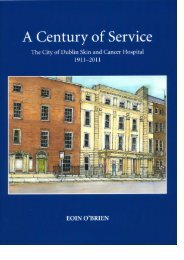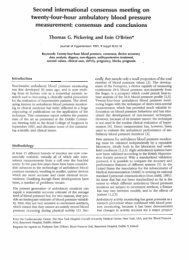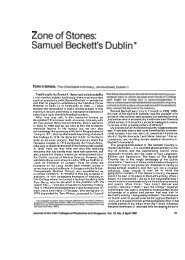Nevill Johnson: Paint the smell of grass - Eoin O'Brien
Nevill Johnson: Paint the smell of grass - Eoin O'Brien
Nevill Johnson: Paint the smell of grass - Eoin O'Brien
Create successful ePaper yourself
Turn your PDF publications into a flip-book with our unique Google optimized e-Paper software.
The third almost suggests collage, which <strong>Johnson</strong> does not seem to have used until <strong>the</strong> 1970s.<br />
They both suggest illusion and destroy it. Stones and shells seem to sit on a ledge but also are<br />
placed on o<strong>the</strong>r planes that shift our perceptions <strong>of</strong> <strong>the</strong> space. The sky in ano<strong>the</strong>r work <strong>of</strong> <strong>the</strong> time,<br />
Monkstown Whorl, is pulled apart as if it were a piece <strong>of</strong> material, for <strong>the</strong> sun to shine through.<br />
The pr<strong>of</strong>essional progress which <strong>Nevill</strong> <strong>Johnson</strong> had made in <strong>the</strong> years he had spent so far in<br />
Dublin was remarkable. Much <strong>of</strong> <strong>the</strong> work he exhibited well into his time in Dublin was probably<br />
painted in Ulster, or at <strong>the</strong> time he moved south, but <strong>the</strong>re had by 1950 been a striking shift towards<br />
a more formally complex and intellectually ambitious manner <strong>of</strong> painting, which <strong>the</strong>n dominated <strong>the</strong><br />
increasingly dark paintings <strong>of</strong> <strong>the</strong> 1950s. His standing amongst <strong>the</strong> Dublin art world was rising and<br />
<strong>the</strong> critic <strong>of</strong> <strong>the</strong> Dublin Magazine wrote <strong>of</strong> his 1952 exhibition that it “shows such phenomenal<br />
development since his one-man show <strong>of</strong> last year that…I feel that <strong>Johnson</strong> can be numbered<br />
amongst that first half-dozen important modern painters in <strong>the</strong> country at <strong>the</strong> moment.<br />
“I am not suggesting that his line <strong>of</strong> development has changed: he is still concerned with <strong>the</strong><br />
creation <strong>of</strong> a personal symbolism. But whereas formerly his detachment, expressed through an<br />
extreme austerity in execution, deprived his work <strong>of</strong> depth, a considerable proportion <strong>of</strong> his more<br />
recent pictures show him to be a painter not only <strong>of</strong> imagination, but <strong>of</strong> feeling. In o<strong>the</strong>r words his<br />
intellectualism has become fused with emotion and his imagination tempered with feeling. A picture<br />
like Harlequin or À la Recherche, though basically formal creations, contains at <strong>the</strong> same time an<br />
element <strong>of</strong> poetry which raise <strong>the</strong>m far above <strong>the</strong> limitations <strong>of</strong> abstraction. They are satisfying, not<br />
merely architecturally, but emotionally. Lot’s Wife, though nearer to abstraction, has an impressive<br />
dignity <strong>of</strong> form. Some <strong>of</strong> <strong>the</strong> less ambitious pictures, <strong>the</strong> gay and strongly-coloured King, or <strong>the</strong><br />
direct and simple Cat, show <strong>Johnson</strong>’s newly acquired freedom in his approach to paint.”<br />
It is revealing that <strong>the</strong> most observant and acute writing on <strong>Johnson</strong>’s work dates from this<br />
period in Dublin. <strong>Johnson</strong> always recalled his life in Dublin with pleasure, “day to day living<br />
passed unhurried, inexpensive, and a light-footed sanity prevailed.” His success with<br />
Waddington’s and at <strong>the</strong> Irish Exhibition <strong>of</strong> Living Art was increased by high pr<strong>of</strong>ile London<br />
exhibitions such as that arranged by Waddington at Heal’s and particularly at Arthur Tooth and<br />
Sons, a gallery which exhibited contemporary British artists, such as Henry Moore, as well as<br />
nineteenth century European painters. In hindsight it prefigures Waddington’s interest in <strong>the</strong><br />
wider market for paintings outside Ireland, but it must have promised much for his Ulster artists<br />
too. <strong>Johnson</strong>’s work was also included in an exhibition, Contemporary Ulster <strong>Paint</strong>ings held in<br />
Edinburgh in 1951 by <strong>the</strong> Scottish Committee <strong>of</strong> <strong>the</strong> Arts Council. He was represented by <strong>the</strong><br />
painting bought by Zoltan Lewinter Frankl and most <strong>of</strong> <strong>the</strong> exhibition was indeed drawn from<br />
this remarkable and wide-ranging collection.<br />
In moving to Dublin, <strong>Johnson</strong> to a degree abandoned <strong>the</strong> middle classes and <strong>the</strong> concomitant<br />
security, and found a world <strong>of</strong> outsiders with whom he felt a sense <strong>of</strong> liberation. As he wrote,<br />
40 <strong>Nevill</strong> <strong>Johnson</strong> l <strong>Paint</strong> <strong>the</strong> Smell <strong>of</strong> Grass<br />
Still Life with Falling Leaves<br />
“There existed a fair degree <strong>of</strong> inequality in Dublin in <strong>the</strong> fifties. The poor remained poor,<br />
observing <strong>the</strong>ir stations; secure in <strong>the</strong> knowledge that poverty lay ahead, well-defined.” He recalls<br />
a small and dingy bar in Dublin where he was first treated with suspicion and gradually accepted<br />
in a strange euphoria <strong>of</strong> sympathy and solidarity. In having no obligations, perhaps, <strong>Johnson</strong> could<br />
choose friends according to his own conscience, and it seems likely that alongside his anger is a<br />
sense <strong>of</strong> guilt at having been part <strong>of</strong> <strong>the</strong> class <strong>of</strong> <strong>of</strong>ficers, politicians and businessmen who held<br />
<strong>the</strong>mselves apart from <strong>the</strong> underclasses <strong>the</strong>y had helped to create.<br />
In this we can perhaps see <strong>the</strong> starting point for one <strong>of</strong> <strong>the</strong> most remarkable <strong>of</strong> <strong>the</strong> many<br />
diverse projects <strong>Johnson</strong> pursued throughout his life. It was probably in 1952 that he began to<br />
photograph on a systematic basis <strong>the</strong> Dublin he later described as The People’s City. It was a city<br />
<strong>of</strong> slums decayed from Georgian grandeur, <strong>of</strong> a freewheeling spirit that just survived <strong>the</strong> poverty,<br />
disease and lack <strong>of</strong> opportunities that was all it <strong>of</strong>fered <strong>the</strong> inhabitants <strong>of</strong> <strong>the</strong> areas that <strong>Johnson</strong><br />
visited. It was a city <strong>of</strong> markets, carts and pubs that seemed to have avoided <strong>the</strong> mechanisation<br />
that had irrevocably altered o<strong>the</strong>r European cities, that almost recalled <strong>the</strong> Paris Ernest<br />
Hemingway had written <strong>of</strong> almost half a century earlier. It was also a city dominated by <strong>the</strong><br />
<strong>Nevill</strong> <strong>Johnson</strong> l The Dublin years 1947–1958 41


